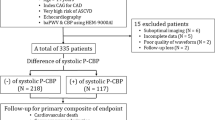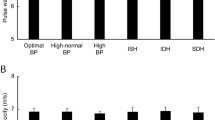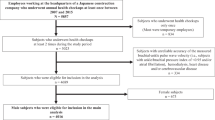Abstract
Both brachial blood pressure (BP) level and its variability (BPV) significantly associate with left ventricular (LV) structure and function. Recent studies indicate that aortic BP is superior to brachial BP in the association with LV abnormalities. However, it remains unknown whether aortic BPV better associate with LV structural and functional abnormalities. We therefore aimed to investigate and compare aortic versus brachial BPV, in terms of the identification of LV abnormalities. Two hundred and three participants who underwent echocardiography were included in this study. Twenty-four-hour aortic and brachial ambulatory BP was measured simultaneously by a validated BP monitor (Mobil-O-Graph, Stolberg, Germany) and BPV was calculated with validated formulae. LV mass and LV diastolic dysfunction (LVDD) were evaluated by echocardiography. The prevalence of LV hypertrophy (LVH) and LVDD increased significantly with BPV indices (P⩽0.04) in trend tests. After adjustment to potential confounders, only aortic average real variability (ARV), but not brachial ARV or weighted s.d. (wSD, neither aortic nor brachial) significantly associated with LV mass index (P=0.02). Similar results were observed in logistic regression. After adjustment, only aortic ARV significantly associated with LVH (odds ratio (OR) and 95% confidence interval (CI): 2.28 (1.08, 4.82)). As for LVDD, neither the brachial nor the aortic 24-hour wSD, but the aortic and brachial ARV, associated with LVDD significantly, with OR=2.28 (95% CI: (1.03, 5.02)) and OR=2.36 (95% CI: (1.10, 5.05)), respectively. In summary, aortic BPV, especially aortic ARV, seems to be superior to brachial BPV in the association of LV structural and functional abnormalities.
This is a preview of subscription content, access via your institution
Access options
Subscribe to this journal
Receive 12 digital issues and online access to articles
$119.00 per year
only $9.92 per issue
Buy this article
- Purchase on Springer Link
- Instant access to full article PDF
Prices may be subject to local taxes which are calculated during checkout



Similar content being viewed by others
References
Parati G, Pomidossi G, Albini F, Malaspina D, Mancia G . Relationship of 24-h blood pressure mean and variability to severity of target-organ damage in hypertension. J Hypertens 1987; 5: 93–98.
Eguchi K, Ishikawa J, Hoshide S, Pickering TG, Schwartz JE, Shimada K et al. Night time blood pressure variability is a strong predictor for cardiovascular events in patients with type 2 diabetes. Am J Hypertens 2009; 22 (1): 46–51.
Vishram JK, Dahlöf B, Devereux RB, Ibsen H, Kjeldsen SE, Lindholm LH et al. Blood pressure variability predicts cardiovascular events independently of traditional cardiovascular risk factors and target organ damage: a LIFE substudy. J Hypertens 2015; 33 (12): 2422–2430.
Sander D, Kukla C, Klingelhofer J, Winbeck K, Conrad B . Relationship between circadian blood pressure patterns and progression of early carotid atherosclerosis: A 3-year follow-up study. Circulation 2000; 102: 1536–1541.
Sega R, Corrao G, Bombelli M, Beltrame L, Facchetti R, Grassi G et al. Blood pressure variability and organ damage in a general population: results from the PAMELA study. Hypertension 2002; 39: 710–714.
Webb AJ, Fischer U, Mehta Z, Rothwell PM . Effects of antihypertensive-drug class on interindividual variation in blood pressure and risk of stroke: a systematic review and meta-analysis. Lancet 2010; 375: 906–915.
Devereux RB, Alderman MH . Role of preclinical cardiovascular disease in the evolution from risk factor exposure to development of morbid events. Circulation 1993; 88: 1444–1455.
Kollias A, Lagou S, Zeniodi ME, Boubouchairopoulou N, Stergiou GS . Association of central versus brachial blood pressure with target-organ damage: systematic review and meta-analysis. Hypertension 2016; 67: 183–190.
de Luca N, Asmar RG, LondonGM, O’Rourke MF, Safar ME . Selective reduction of cardiac mass and aortic blood pressure on low-dose combination perindopril/indapamide in hypertensive subjects. J Hypertens 2004; 22: 1623–1630.
Manisty CH, Zambanini A, Parker KH, Davies JE, Francis DP, Mayet J et al. Differences in the magnitude ofwave reflection account for differential effects of amlodipine- versus atenolol-based regimens on aortic blood pressure: an Anglo-Scandinavian Cardiac Outcome Trial substudy. Hypertension 2009; 54: 724–730.
Vlachopoulos C, Aznaouridis K, O'Rourke MF, Safar ME, Baou K, Stefanadis C et al. Prediction of cardiovascular events and all-cause mortality with central haemodynamics: a systematic review and meta-analysis. Eur Heart J 2010; 31 (15): 1865–1871.
Protogerou AD, Argyris AA, Papaioannou TG, Kollias GE, Konstantonis GD, Nasothimiou E et al. Left-ventricular hypertrophy is associated better with 24-h aortic pressure than 24-h brachial pressure in hypertensive patients: the SAFAR study. J Hypertens 2014; 32 (9): 1805–1814.
Zhang Y, Kollias G, Argyris AA, Papaioannou TG, Tountas C, Konstantonis GD et al. Association of left ventricular diastolic dysfunction with 24-h aortic ambulatory blood pressure: the SAFAR study. J Hum Hypertens 2015; 29: 442–448.
Mancia G, Fagard R, Narkiewicz K, Redón J, Zanchetti A, Böhm M et al. 2013 ESH/ESC Guidelines for the management of arterial hypertension: the task force for the management of arterial hypertension of the European ociety of Hypertension (ESH) and of the European Society of Cardiology (ESC). J Hypertens 2013; 31: 1281–1357.
Tatasciore A, Zimarino M, Renda G, Zurro M, Soccio M, Prontera C et al. Awake blood pressure variability, inflammatory markers and target organ damage in newly diagnosed hypertension. Hypertens Res 2008; 31 (12): 2137–2146.
Mena L, Pintos S, Queipo NV, Aizpúrua JA, Maestre G, Sulbarán T et al. A reliable index for the prognostic significance of blood pressure variability. J Hypertens 2005; 23 (3): 505–511.
Bilo G, Giglio A, Styczkiewicz K, Caldara G, Maronati A, Kawecka-Jaszcz K et al. A new method for assessing 24-h blood pressure variability after excluding the contribution of nocturnal blood pressure fall. J Hypertens 2007; 25 (10): 2058–2066.
Lang RM, Bierig M, Devereux RB, Flachskampf FA, Foster E, Pellikka PA et al. Recommendations for chamber quantification. Eur J Echocardiogr 2006; 7: 79–108.
Mancia G . Short-and long-term blood pressure variability: present and future. Hypertension 2012; 60: 512–517.
Stolarz-Skrzypek K, Thijs L, Li Y, Hansen TW, Boggia J, Kuznetsova T et al. Blood pressure variability in relation to outcome in the International Database of Ambulatory Blood Pressure in Relation to Cardiovascular Outcome. Hypertens Res 2010; 33: 757–766.
Ohte N, Saeki T, Miyabe H, Sakata S, Mukai S, Hayano J et al. Relationship between blood pressure obtained from the upper arm with a cuff-type sphygmomanometer and central blood pressure measured with a catheter-tipped micromanometer. Heart Vessels 2007; 22: 410–415.
McEniery CM, Cockcroft JR, Roman MJ, Franklin SS, Wilkinson IB . Central blood pressure: current evidence and clinical importance. Eur Heart J 2014; 35: 1719–1725.
Hansen TW, Thijs L, Li Y, Boggia J, Kikuya M, Björklund-Bodegård K et al. Prognostic value of reading-to-reading blood pressure variability over 24 h in 8938 subjects from 11 populations. Hypertension 2010; 55 (4): 1049–1057.
Zhang Y, Zhang X, Liu L, Zanchetti A . Visit-to-visit blood pressure variability and cardiovascular outcomes in felodipine event reduction study. J Hypertens 2015; 33: e46.
Author information
Authors and Affiliations
Corresponding author
Ethics declarations
Competing interests
The authors declare no conflict of interest.
Rights and permissions
About this article
Cite this article
Chi, C., Yu, SK., Auckle, R. et al. Association of left ventricular structural and functional abnormalities with aortic and brachial blood pressure variability in hypertensive patients: the SAFAR study. J Hum Hypertens 31, 633–639 (2017). https://doi.org/10.1038/jhh.2017.37
Received:
Revised:
Accepted:
Published:
Issue Date:
DOI: https://doi.org/10.1038/jhh.2017.37
This article is cited by
-
Blood pressure and its variability: classic and novel measurement techniques
Nature Reviews Cardiology (2022)



